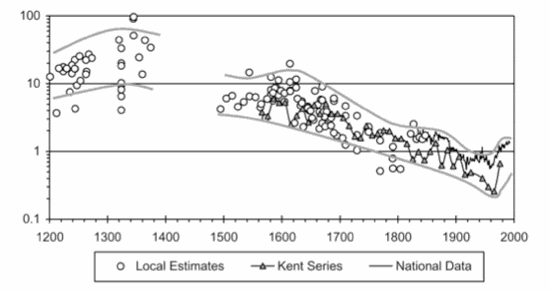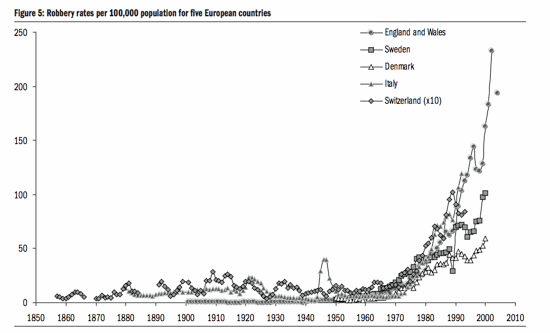Once again, gun control debates are raging in the United States and now, in the Philippines. Every time there is talk about restricting firearms, anti-gun advocates love wheeling out Great Britain as some sort of gold standard. The old narrative should be familiar:
The United States, with 90 guns for every 100 citizens, is the most heavily armed society in the world. As a result of Americans’ stubborn love of their right to bear arms, its cities have become mired in violence, gang shootings and school massacres. Britain, on the other hand, known as having among the strictest gun laws in the world, is a far safer society. Gun crime in the UK is minuscule compared to America and its crime rate is much lower.
Reinforcing this view are the recent spate of mass shootings in the US, together with the announcement that homicide in Britain is at a 30-year low.
It all seems pretty clear cut with these statistics. More guns mean more crime and more deaths. The simple narrative is effective and on the surface, one would have a hard time arguing with it. After all, we’re accustomed by both Hollywood fantasy and real-life news that America is steeped in violence. It is easy to accept.
Challenging the anti-gun narrative
However, things can get quite confusing for an inquiring mind that scratches below the surface. British news reports over the past decade or so tell a different story:
-
“The crime rate in England and Wales is the highest in the industrialised world…also placed towards the very top of the international crime league table for car offences, burglary, sex and violent assaults”, The Independent, 23 February 2001
-
“Gun crime has risen by 35% in a year, new Home Office figures show”, The Daily Telegraph, 2 July 2009
-
“Gun crime has almost doubled in the last decade despite high profile Government campaigns to tackle the problem”, The Daily Telegraph, 27 Oct 2009
-
“Cumbria saw gun crime virtually double while North Yorkshire witnessed a rise of almost half in offences involving a knife or sharp object”, The Daily Telegraph, 16 Jan 2010
These headlines don’t fit the narrative at all. Still, a generous observer can point out that while things look bad in Britain, it’s nothing compared to the carnage in the U.S. It is a fairly trivial task to pull up numbers on gun deaths for both countries to show the huge disparity. And after another round in the game of statistic versus counter-statistic, the gun control advocate can smugly point out that the case is made: more guns equals more gun deaths. Of course, this is true. Guns are dangerous implements that were created to kill so it’s inevitable that more of them would result in more deaths by that very same tool.
The misdirection of gun death statistics
Gun death statistics are actually a misdirection. The real question is whether strict gun control improves society overall, specifically with regard to reduction in violence. We can tease out some clues by stepping back and looking at figures from a much wider timeframe than only a few decades. However, comparing violent crime over long periods of time is tricky since the significance of different classifications of violence has changed through the ages (for example, our notions of marital rape and death by duelling are very different today). We’ll therefore look at murder, which has remained a constantly grave act for hundreds of years.
The first fact to know is that Britain’s murder rate has historically been unusually low. For at least 200 years, even before any gun control measures were introduced in either country, American murder rates have been much higher than Britain’s. Furthermore, even when guns where still widely available in Britain, they were rarely the weapon of choice for British murderers. With this fact alone, the assertion that strict gun control caused Britain’s more favourable statistics can clearly seen to be false. The point is worth repeating: historical evidence shows that gun control had nothing to do with Britain’s lower murder rates nor the lower rate of gun crime.
This story becomes even more interesting when you look back further in time. To appreciate the data, you should know some key dates for gun control legislation in Britain.
-
The first serious British gun control legislation was introduced in the 1920 Firearms Act. This made the right of individuals to bear arms ‘conditional upon the Home Secretary and the police’.
-
The next huge steps towards gun control came after the 1987 Hungerford mass shooting and 1996 mass shooting in Dunblane. The Firearms Act 1988, placed most rifles on the Prohibited list and the 1997 Firearms Act essentially banned private possession of handguns.
Remember the gun control narrative which is that the series of gun control legislation introduced since 1920 has transformed Britain into the more peaceful society it is today, at least when compared to the United States.
Now let’s look at the historical indicators of homicides per 100,000 population in England, from the thirteenth to twentieth centuries. In Graph 1 below we see seven centuries of declining homicide rates suddenly countered by a sudden upsurge at the late twentieth century, just when strict gun control was imposed.

Graph 1: Homicide rates in Britain, 1200-2000 (source)
To add a little more depth to this line of thought, let’s look at robbery rates in Britain from 1850 to 2010. The steep incline in late 1990s shown by Graph 2 speaks for itself. This exactly coincides with the point when the British government eventually banned firearms from civilian hands.

Graph 2: Robbery rates in Britain, 1850-2010 (source)
I am sure that the persistent gun abolitionist will be able to find some way of explaining away these facts. After all, they to excel at cherry-picking data to suit their agenda. For example, in this video, the content author pulls current statistics from the FBI and Home Office. He discovers:
- England and Wales has 3.5 times the violent crime rate of the U.S.
- There has been 50% decrease in violent crime over the last 20 years in the United States. (Compare this to the increase in Britain’s violent crime rate referenced above.)
- The bulk of violent crime in the US is isolated to high density metropolitan areas population of over 250,000.
This parallels statistics from nationmaster.com that a higher percentage of the British population were victims of assault as compared to Americans (2.8% of the British population versus 1.2% of the American population).
Britain is far from the peaceful gunless society that anti-gun advocates would have you believe. In fact the evidence strongly suggests that gunless Britain is a far more violent place than the United States.
Real-world experience
Many articles like this quote dry statistics and a fair rebuttal is that they will never match the real experience of a resident. Things can look a certain way ‘on paper’ but it may be nothing like life in the country itself for the average citizen. Fortunately, I’m well placed to answer this as I’ve spend significant parts of my life in the UK, US and the Philippines.
While in the UK between the period of 1990 and 2008, I’ve personally experienced the following:
- Two house robberies (in two different houses about a decade apart)
- An attempted mugging in broad daylight (the perpetrator aborted his attack)
- Being chased by skinheads (I escaped by running into a train station)
- Witnessing an attempted abduction in a busy shopping street
- Witnessing an assault outside our home in the early hours of the morning
- Witnessing an ambush attack while drinking with friends in a pub
- Witnessing a street fight involving four young men
- Witnessing a man beating a crouched victim with a belt in a crowded tourist area
The following were relayed to me by friends who were victims, witnesses, or from police questioning:
- Police questioned residents about a broad daylight robbery of neighbours’ apartments (approx. 4 apartments in the same day)
- A family friend was attacked by a home intruder; the doorman of her building was knocked unconscious
- An intruder entered my sister’s house while she, her husband and their children we at home
- A friend witnessed a mugging in broad daylight
- Police questioned residents about a mugging by knife-point outside our house
- A friend heard gunshots while viewing a house for rent (obviously he decided not to move into that area)
Of course, my anecdotes cannot be counted as serious evidence. Nevertheless, they may in some way endorse the bookworm facts; this isn’t simply a case of trawling the internet for statistics without having any first-hand experience about the subject. (For the record, I did not live in the rough inner-city where one may expect these things to happen.)
A gunless society in the Philippines
With several high-profile firearms crimes in the Philippines occurring during January 2013, there is once again noisy clamour from advocates for a ‘gunless society.’ There are calls for a permanent gun ban. No doubt, Britain will be raised as a shining example of successful gun control.
In May 2010, when the PNP Chief at the time, General Jesus Verzosa, proposed a permanent total gun ban, I wrote an article about the effects of gun prohibition laws in Jamaica. Back then, I said that a crackdown on civilian ownership will be a disaster for law and order in the Philippines. After reviewing the statistics from Britain, my views remain the same.
Britain is yet another excellent example of the effects of gun control. And once again, the facts simply don’t line up in the way anti-gun advocates would like to portray.

The point that guns are not the preferred weapon of choice in the UK for committing crimes is well taken. In other words, crimes are still rampant in the UK except that the criminals may use other implements. This can truly distort the statistics by the false claim that there is actually less shooting incidents in the UK and thus less crime. Apparently, not.